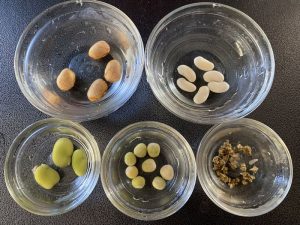Soaking seeds before planting
Robin Gale-Baker, from Sustainable Macleod discusses pre-soaking veggie seeds before planting. This is one of a series of articles she has written about growing various veggies (see right hand sidebar). She has also written a number of articles about growing various herbs, growing various fruit trees and general growing techniques.
 Seed soaking is a technique used by gardeners for some, but not all, seeds. The seeds that are suitable for soaking before planting are those that need lots of moisture and light to germinate and/or have a tough or wrinkly outer covering. Tiny seeds are not suitable. For veggies, the main seeds that can usefully be pre-soaked are:
Seed soaking is a technique used by gardeners for some, but not all, seeds. The seeds that are suitable for soaking before planting are those that need lots of moisture and light to germinate and/or have a tough or wrinkly outer covering. Tiny seeds are not suitable. For veggies, the main seeds that can usefully be pre-soaked are:
- Peas, beans and broad beans.
- Cucumbers, pumpkins and sweetcorn.
- Silverbeet (aka chard) and beetroot.
There is not much dispute about the lists about though some people are not in favour of soaking beans, saying that they sometimes split within hours.
Seeds comprise an embryo inside an outer, protective covering. In simple terms, germination occurs when the embryo ‘shoot’ breaks through the outer covering. To do this, the seed needs a source of constant moisture, and light or darkness depending on what it is (e.g. lettuce germinates in light but tomato seed needs to be covered with soil which provides darkness). The thicker the seed casing the slower the seed germinates (the thick casing of some seeds is protective because the seed may be subjected to stresses such as cold, bruising, being trodden on, etc and needs to survive these till spring).
Pre-soaking seeds has a number of potential advantages: it triggers germination, speeds it up, provides a quick start where a short growing season for a vegetable is critical, and breaks down any inhibitors on the seed more quickly than in nature. There is no evidence that it increases germination in quality seed – either the seed is viable or it is not.
When soaking seeds, cover them with lukewarm water (not hot water). Depending on the thickness of the seed coat, soak anywhere between 8 and 24 hours. In preparation for this article, I soaked 5 lots of seed including bean, pea, broad bean, borlotti bean and beetroot. None of them split until day 5 so I think any seed soaked for up to 24 hours will be fine. I soak my seeds overnight, putting it in lukewarm water just before I go to bed and planting it when I get up the next morning.
Seeds as small as silverbeet and beetroot right up to large pumpkin seeds are easy to handle when wet. They can be placed in drills relatively easily and spaced well so that little thinning is required. On the other hand, seeds such as lettuce would be a nightmare to spread as they would clump together and separating them would be impossible.
Some people add vinegar to the soaking water in the belief that this will emulate the acidic condition of an animal’s stomach and break down the casing more quickly but this is unproven. Others suggest adding some Seasol or Maxicrop to the water; whilst this may give the seed some extra nutrients to see it on its way, I have not found this to be necessary.
The photo right is after around 48 hours in water.
